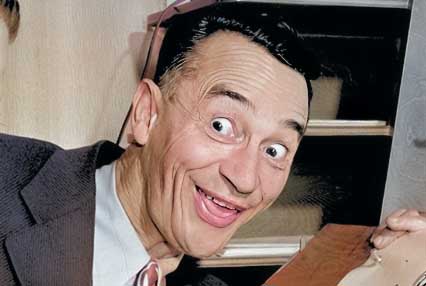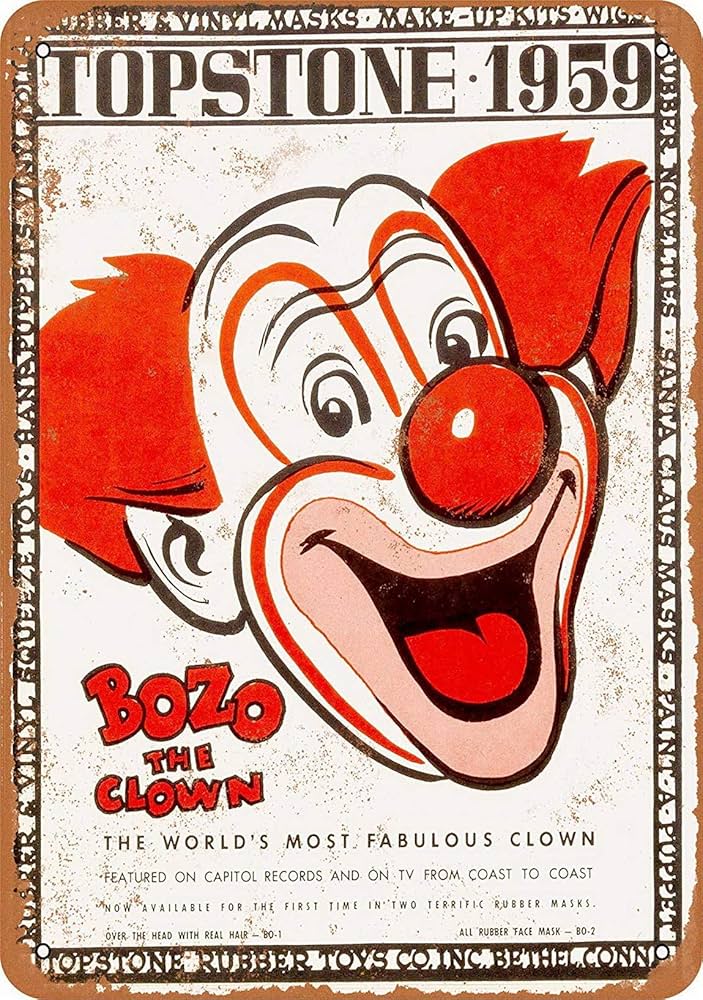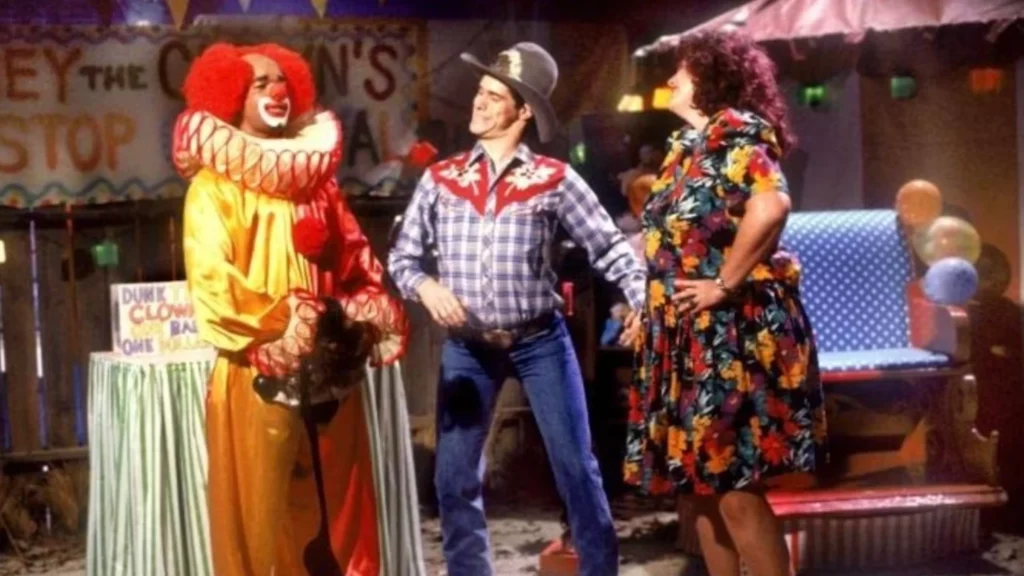
photo: Pinto Colvig the original Bozo the Clown
“American Clown” The Documentary Stemming from “Bozo the Clown”.
I have been planning this blog/essay about Bozo the Clown for a few months. Today was finally meant to be the day. In gathering a few online bits regarding Bozo I saw a strange short youtube video of a small gathering of Clowns in the USA. In the intro there is mention of a coming documentary on USA clowns.
That documentary has since been made. I watched that documentary today via an online rental.
More about that in a moment. First is Bozo. Rightfully so because, “Bozo the Clown” was hugely influential for clowning in the USA. More about that follows immediately.

Part 1 Introduction to Bozo and TV clowning in the USA
Part 2 A short online article about the history of the word ‘bozo’
Part 3 Information regarding a recent documentary about American style of clown from the tradition of Bozo, etc.
Part 1 Introduction to Bozo and TV clowning in the USA
In my books I have mentioned that what I call The Clown Movement that began in 1947 via a magicians convention in Pittsburgh. There was a Clown, Happy Dayze – Art Jennings, Snr. Art helped begin there and then another organization – The International Jugglers Association – the IJA. Some of the magicians were also jugglers. Some magicians and some jugglers were also Clowns. Jennings was particularly instrumental due to the fact that he was a magician, juggler, and clown. And he and the other IJA founders wanted to ensure that the IJA got off to a good start.
Here are two short links that give a lot of very interesting information about Art, Snr as a clown and person!!
http://www.juggling.org/jw/87/2/happydayze.html
https://dev.juggle.org/business/newsletters/IJAnews-2007-08.pdf
Coincidentally many years later I became a friend and theatre colleague acting with Art’s son, Art Jennings, Jnr who was also a magician, juggler, clown. He was also a very fine classical actor. An Emcee. A comedian. An English teacher. Art,Jnr taught me to juggle.
He saw what I was like and the first step of teaching took a maximum of 2 minutes and I was excitedly juggling the 3 lacrosse balls. Another 2 minutes and I could actually contol the balls better. So Art being Art… explained what we would do next and he started to feed in the basic juggling ball passing pattern. In about another 2 minutes we were able to pass six balls in a basic pattern.
I loved that and we had fun. Soon on a vacation I bought 3 lacrosse balls. I began to practice on my own a variety other “tricks of the trade” en route to becoming a clown.
As mentioned Art Jennings, Snr and a few fellow magician/jugglers began IJA in 1947. In England others began Clowns International in 1947. From France into Italy, Marcel Marceau began to tour his Mime & Clown show in 1947 and for nearly 60 years more. The great dramatic film Children of Paradise featuring the sad clown Pierrot, was released internationally first in the USA in 1947. In 1947 Children of Paradise‘s screenplay/screen writer won an Academy Award.
Bozo the Clown began on TV in 1948. But Bozo started as a clown in children’s books that were also read on Radio. The first recording is linked in this blog.
“Bozo the Clown” become an American phenomenon in books, radio when television began to explode so too did Bozo the Clown – one regional TV channel at a time. However, soon enough Bozo went from one local channel and one person playing the role up to 180 local channels having their own place for Bozo. That is for one local actor playing Bozo on their local TV channel. Peaking some years later at 180 local channels each with their own Bozo.
Already by the late 1940’s television used veteran clowns who were already popular due mainly to their decades of fame performing in Vaudeville, Radio, Film, Burlesque. Buster Keaton, Ed Wynn, and Milton Berle had their own clown TV programs. These popular clowns were each the star/host/emcee of their show. Berle would have been involved in producing. Martin & Lewis were sometimes hosts of The Colgate Comedy Hour. “The Abbott and Costello Show” featured Bud Abbott and Lou Costello as out-of-work actors and roommates staying at Mr. Field’s Hollywood boarding house. The clown Joe Besser was a regular on the show. In 1954 the fantastic Clown, Pinky Lee began his children’s show.
The clowns shows also featured a wide range of Vaudeville, Variety, and Novelty acts as guest artists. Gertrude Berg already had the most popular radio show for 20 years and was the originator of what became known as Sitcom – situation comedies even in Radio. Berg was the writer of thousands of 15-minutes ‘sitcom’ episodes. In the beginning sitcoms were primarily domestic situations such as I Love Lucy, and The Danny Thomas Show, and many others. Most were ‘clown’ shows based around real life turning clownish.
A Bozo parody. From the 1990’s TV show In Living Color. With Damon Wayans as Homey D Clown with Jim Carrey.

Back to the early days of TV, in other countries there were local TV channels with children’s shows many of which included Clowns and/or puppetry were important beginnings. Some of the puppets were clowns of various sorts. In 1946 in England their first children’s show, For The Children, featured a pianist/singer Annette Mills who interacted with the clown puppet that was Muffin the Mule. The show also featured other of the Hogarth Puppets and their puppet circus with Muffin as the main clown character.
Part 2 – The History of the Word ‘bozo’. Article by Ben Zimmer.
“For many decades, the word bozo has been intimately linked to Bozo the Clown, a character that started off on a 1946 children’s album and accompanying read-along book from Capitol Records. Bozo made the move to television in 1949, and later the character became a nationwide franchise, with different “Bozo” shows broadcast in regional markets (most famously Bob Bell, the Bozo for WGN in Chicago).
Larry Harmon, who bought the licensing rights for Bozo in 1956, was responsible for making the clown a national sensation, and he also guarded the name closely. When a Tennessee restaurant named Bozo’s Hot Pit Bar-B-Q sought a trademark for “Bozo,” Harmon fought back in court, even though the restaurant was named for a fellow nicknamed “Bozo” Williams back in 1923, well before the clown hit the airwaves.
According to a 1991 New York Times article about the dispute, Harmon floated the outlandish claim that the name “Bozo” goes back to “a book about gypsy comedians written in either the 11th or 13th century.” And a subsequent letter to the Times made the equally ludicrous suggestion that “Bozo” might go back to an “obtuse” 11th-century monk from Normandy named Boso who figures in a work by St. Anselm, Archbishop of Canterbury.
More plausible etymological theories suggest bozo comes from a Spanish source, such as bozal, which could mean “simple,” “stupid,” or “unable to speak Spanish well.” Another theory relates it to a meaning of bozo in Spanish that refers to the “peach fuzz” on the cheeks of adolescent boys. And yet another suggests that it comes from a Spanish-Dutch creole on the island of Curaçao known as Papiamento, in which boso could mean “You people” (a shortening of the Spanish second-person plural pronoun vosotros).
None of these speculations are based on firm evidence, however. While the epithet bozo did not originate with Bozo the Clown, the earliest print examples date to about 1920. Bozo crops up in a few diaries of World War I soldiers that were later published for a mass audience, in familiar contexts like “you old bozo” and “that’s right, bozo.”
But how did it get so familiar? Bozo might have come into circulation thanks to a precursor of Bozo the Clown: a vaudeville character named Bozo from the early 20th century. So suggests some new research by Peter Reitan on his Early Sports and Pop Culture History Blog. (Reitan previously pitched in with some great research on the phrase “get one’s goat.”)
Reitan uncovered the history of a vaudeville act involving Edmond Hayes as “wise guy” Spike Hennessey and his sidekick “Bozo,” appearing as early as 1911 in a routine where they play piano movers causing mayhem among high-society types. “Bozo” was originally played by Bobby Archer, but the character gained greater fame played by Tommy Snyder starting in 1914. The new actor became so associated with the role that he was popularly known as “Bozo” Snyder. His silent “tramp” character, played in pantomime, was said to have influenced Charlie Chaplin’s Little Tramp.
“Bozo” was in fact a personal name among immigrants to the United States from Serbian and Croatian regions. It seems likely that vaudeville’s Bozo originated from this immigrant name and stereotypes surrounding eastern Europeans (akin to the use of palooka to refer to an oafish boxer, probably related to the Polish name Paluka).
Reitan’s blog provides much more historical background, and his research continues. He recently came across a 1906 notice in the New York Clipper advertises a circus performer named “The Great Bozo, Hoop Roller and Barrel Jumper.” But even if there are earlier precursors, it seems quite likely that Tommy “Bozo” Snyder brought fame to the name, long before Bozo the Clown became a television staple.”
Writer of that article: Ben Zimmer is language columnist for The Wall Street Journal and former language columnist for The Boston Globe and The New York Times Magazine. He has worked as editor for American dictionaries at Oxford University Press and as a consultant to the Oxford English Dictionary. In addition to his regular “Word Routes” column here, he contributes to the group weblog Language Log. He is also the chair of the New Words Committee of the American Dialect Society.
The following item is from a fb site regarding early days of TV.
“Vance Pinto Colvig was indeed the original Bozo, bringing the character to life first in the 1940s. He starred in “Bozo at the Circus,” which was the first “Reading Record” — a pioneering concept combining a children’s book with a phonograph record, allowing kids to read along while listening to the story. Pinto’s engaging performances on these recordings and his personal appearances over a span of about ten years helped make Bozo a beloved figure and propelled the character to world fame. His portrayal was foundational in defining Bozo’s personality and style.
Later, Capital Records, which produced these “Reading Records,” hired other performers to imitate Pinto’s Bozo. One of these actors was Larry Harmon, who learned to impersonate Pinto’s version of Bozo so well that when Capital Records retired the character, Harmon acquired the rights and transformed Bozo into a television franchise. Harmon’s vision expanded Bozo beyond audio recordings into a live-action TV phenomenon that spread nationwide.
The first Bozo TV show aired in Los Angeles, with Vance Pinto Jr., the son of the original Bozo, playing the role and imitating his father’s famous characterization. This helped maintain continuity and honored the original performance style while adapting to the new TV format.
In the famous Chicago Bozo show — one of the longest-running and most iconic versions — episodes often featured Marshall Brodien as Wizzo the Wizard, a side character known for performing magic tricks that entertained children and complemented Bozo’s clown antics.
Regarding Cooky the Clown, played by Roy Brown, there is evidence suggesting that Brown’s health declined at some point, causing him to appear less frequently. During his absence, the show brought in other performers and acts to fill the gap, ensuring the program continued to entertain its young audience without interruption.”
“I was born in Jacksonville and named Vance DeBar Colvig. At age 7 (because of too many freckles, and goony antics) I was nicknamed ‘Pinto the Village Clown’ (which I have used professionally during my circus and other show business activities, besides occasional jobs as a newspaper cartoonist.
— “‘Pinto’ Colvig Writes About Names, History of Clowning”, Medford Mail Tribune, July 12, 1961″
“In 1913, Colvig worked the Pantages Theatre Circuit, briefly, before leaving for clarinetist in the Al G. Barnes Circus band for part of a season. In 1914 he was a newspaper cartoonist in Reno, Nevada and then in Carson City, then again clarinetist in the Al G. Barnes Circus band for part of the 1915 season.”
“I didn’t know when I was going to school whether I wanted to be a clown, draw cartoons, write, hobo, or be a musician. So I wrapped it all up and made a stew of it. – Pinto Colvig”
The following recording is the first Bozo. Portrayed by Pinto Colvig. A record recording that was meant to be played while the listening audience, the children, could follow along with their book. By the time Colvig made this record he had 30 years experience as a cartoonist and voice actor. He created over 150 animations and nearly as many ‘voices’/characters.
Part 3 Information regarding a recent documentary about American style of clown from the tradition of Bozo, etc.
There is a huge variety of American Clowns!! Although the documentary is trying to focus on one ‘type’ it becomes more varied as the documentary goes on. That is just one of the positive attributes of “American Clown” (2025). The story throughline is excellent. The editing is excellent. The sampling of American Clown is narrow enough to make a story throughline plausible.
When it says ‘American Clown’ remember, it is generally not discussing: Buster Keaton nor Diane Keaton; not Harold Lloyd nor Fanny Brice; not ‘Stuart’ of MAD-TV nor ‘Homey D. Clown’ of In Living Color; not Gilda Radner nor Gene Wilder; not Bert Williams nor Red Skelton; and an immensely long and broad list of other American Clowns.
But I am particularly thankful that this documentary sheds some light onto and into Ringling’s unique style of American clowning. In particular via the few individuals selected to share their passion for ‘just being a clown’.
Guillford Adams and Casey Pinkston created the film. Guillford is the main story teller sometimes as he shares his experience of clowning but importantly as one of the two people who really created this fine survey. The other co-creator Pinkston is the brilliant Editor. They and whoever assisted them did a very fine job of selecting footage from a variety of sources. The selection and timing of the footage added immensely to this documentary’s quality.
Importantly, as I have just indicated above the breadth of American Clowns is enormous and wonderful.
The film can be rented or bought online.
Thanks for reading and viewing. There are now approximately 100 of my blog/essays available at www.iraseid.com/blog
On the same site see I.S.A.A.C. Creative Mentorship – the long distance, part-time way to learn tools to move ahead with continually – www.iraseid.com/mentorship
Contact: iraseid@gmail.com